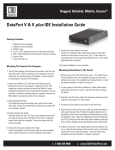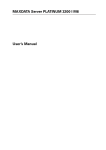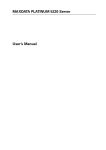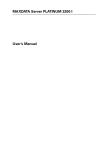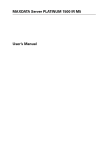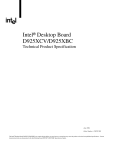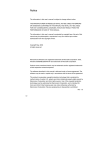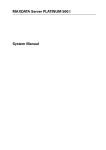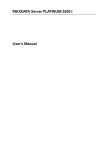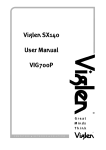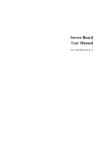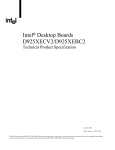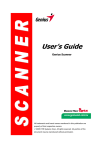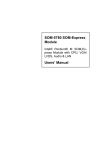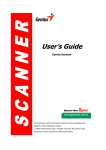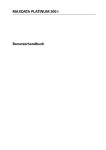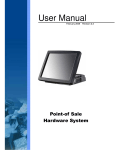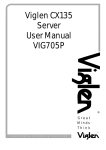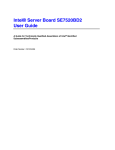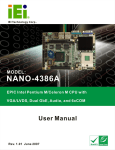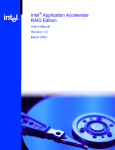Download User`s Manual MAXDATA Server PLATINUM 3200 I M5
Transcript
MAXDATA Server PLATINUM 3200 I M5 User’s Manual 2 Contents Contents 1 Setting up the System 7 Server Position ........................................................................................................................................7 Connecting the System ...........................................................................................................................8 Back Panel Connectors ......................................................................................................................8 Front Panel Controls and Indicators ........................................................................................................9 2 Chassis Description 11 Feature Summary ..................................................................................................................................11 Chassis Front View ................................................................................................................................12 Base Chassis Rear View ........................................................................................................................13 Base Redundant Power Chassis Rear View ..........................................................................................14 Peripherals .............................................................................................................................................14 5.25inch Halfheight Peripheral Bays.................................................................................................14 3 Setting up the Chassis 15 Tools and Supplies Needed ..............................................................................................................15 Safety: Before You Remove the Access Cover................................................................................15 Warnings and Cautions .........................................................................................................................15 Remove Primary Access Cover .............................................................................................................16 Remove Bezel Assembly ......................................................................................................................16 Install 3.5-inch Floppy, DVD or CD-ROM Drive .....................................................................................17 Install Fixed Hard Drive(s) ......................................................................................................................18 Install Hot Swap Drive(s) .......................................................................................................................20 4 Server Board Features 23 Connector and Header Locations ..........................................................................................................25 Configuration Jumpers ..........................................................................................................................26 Hardware Requirements .......................................................................................................................27 Processor .........................................................................................................................................27 Memory ............................................................................................................................................27 5 Hardware Installations and Upgrades 29 Before You Begin ..................................................................................................................................29 Tools and Supplies Needed ...................................................................................................................29 Installing and Removing Memory ..........................................................................................................29 Installing DIMMs ..............................................................................................................................29 Installing or Replacing the Processor ....................................................................................................30 Installing the Processor ....................................................................................................................30 Installing the Heat Sink(s) .................................................................................................................31 Removing a Processor .....................................................................................................................31 Installing or Removing a PCI Card .........................................................................................................32 Replacing the Backup Battery ...............................................................................................................32 6 Server Utilities 35 Using the BIOS Setup Utility .................................................................................................................35 Starting Setup...................................................................................................................................35 If You Cannot Access Setup.............................................................................................................35 Setup Menus ....................................................................................................................................35 7 Troubleshooting 37 BIOS POST Beep Codes .......................................................................................................................37 BIOS Recovery Beep Codes .................................................................................................................38 MAXDATA Server PLATINUM 3200 I M5 3 8 Technical Reference 39 Power Supply Specifications .................................................................................................................39 600-W Single Power Supply Input Voltages .....................................................................................39 600-W Single Power Supply Output Voltages ..................................................................................39 730-W Single Power Supply Input Voltages .....................................................................................39 730-W Single Power Supply Output Voltages ..................................................................................39 System Environmental Specifications ...................................................................................................40 9 Regulatory and Integration Information 41 Product Regulatory Compliance ............................................................................................................41 Product Safety Compliance ..............................................................................................................41 Product EMC Compliance ....................................................................................................................41 Product Regulatory Compliance Markings ............................................................................................41 Electromagnetic Compatibility Notices .................................................................................................42 FCC (USA) ........................................................................................................................................42 Europe (CE Declaration of Conformity) ............................................................................................42 Installation Precautions .........................................................................................................................42 Installation Requirements ......................................................................................................................43 Prevent Power Supply Overload ......................................................................................................43 Place Battery Marking ......................................................................................................................43 Use Only for Intended Applications .......................................................................................................43 4 Contents Figures 1. 2. 3. 4. 5. 6. 7. 8. 9. 10. 11. 12. 13. 14. 15. 16. 17. 18. 19. 20. 21. 22. 23. 24. 25. Back Panel Connectors .....................................................................................................................8 Pedestal Controls and Indicators .......................................................................................................9 MAXDATA PLATINUM 3200 I Base Front View ............................................................................12 MAXDATA PLATINUM 3200 I Base Chassis Rear View ................................................................13 MAXDATA PLATINUM 3200 I Redundant Power Chassis Rear View ............................................14 Removing the Access Cover ...........................................................................................................16 Removing Bezel Assembly..............................................................................................................16 Removing Slide/Filler Panel Assembly from Upper Device Bay ......................................................17 Installing Slides on 3.5-inch Floppy Drive ........................................................................................17 Installing a DVD or CD-ROM Drive ..................................................................................................17 Removing Six-drive Fixed Drive Cage from Chassis .......................................................................18 Unlocking and Opening Upper Drive Cage Door .............................................................................18 Remove Slides from Drive Cage Door ............................................................................................19 Installing Device Slides to Hard Drive .............................................................................................19 Inserting Drive/Slide Assembly into Drive Cage ..............................................................................19 Releasing Drive Carrier from Hot Swap Cage .................................................................................20 Removing Plastic Retention Device ................................................................................................20 Securing Hard Drive to Drive Cage..................................................................................................21 Inserting Drive Carrier into Drive Cage ............................................................................................21 MAXDATA PLATINUM 3200 I Server Board Connector and Header Locations..............................25 Configuration Jumper Location .......................................................................................................26 Installing Memory............................................................................................................................29 Opening Socket Lever .....................................................................................................................30 Inserting Processor ........................................................................................................................31 Replacing the Backup Battery .........................................................................................................33 Tables 1. 2. 3. 4. 5. 6. 7. 8. 9. 10. 11. 12. 13. NIC LED’s ..........................................................................................................................................8 Description of Front Panel LEDs .....................................................................................................10 Feature Summary ............................................................................................................................11 MAXDATA PLATINUM 3200 I Server Board features overview .....................................................23 Server Board Features.....................................................................................................................23 Configuration Jumpers ....................................................................................................................26 Keyboard Commands ......................................................................................................................36 POST Error Beep Codes ..................................................................................................................37 BIOS Recovery Beep Codes ...........................................................................................................38 600-W Power Supply System Output Capability .............................................................................39 730-W Power Supply System Output Capability .............................................................................39 Environmental Specifications ..........................................................................................................40 Product Certification Markings ........................................................................................................41 MAXDATA Server PLATINUM 3200 I M5 5 6 1 Setting up the System Server Position Please take note of the following criteria for creating a practical and safe workplace when setting up your computer: The system can be used anywhere the temperature is suitable for people. However, rooms with humidity over 70 %, and dusty or dirty areas are not appropriate. In addition, do not expose the server to any temperatures over +30 °C or under +10 °C. Make sure that the cables connecting the server to peripheral devices are not tight. Make sure that all power and connection cables are positioned so that they are not trip hazards. When you save data to your server‘s hard disks or to a floppy disk, they are stored as magnetic information on the media. Make sure that they are not damaged by magnetic or electromagnetic fields. Because the electronics in your computer can be damaged by jarring, no mechanical devices should be placed on the same surface as the server. This is especially important for impact printers whose vibrations could damage the hard disk. Please take care to ensure a free air flow to the server at all times. Do not block the ventilation slots of the server case and particularly the power supplies. An insufficient air flow may damage the server and / or it’s components. ATTENTION In order to fully separate the server from current, the power cord must be removed from the wall outlet. MAXDATA Server PLATINUM 3200 I M5 7 Connecting the System Back Panel Connectors � � � � � � � a � � Figure 1. Back Panel Connectors A. USB 1 D. Mouse G. Video B. USB 2 E. Keyboard H. NIC 1 C. USB 3* F. Serial A I. NIC 2 *USB3 not available on MAXDATA PLATINUM 3200 I Server Board The NIC LEDs at the right and left of NIC 1 provide the following information. Table 1. NIC LED’s LED Color LED State Description Left LED Off No network connection is in place Solid Green Network connection is in place Blinking Green Transmit/receive activity Off 10 Mbps connection (if left LED is on or blinking) Solid Green 100 Mbps connection Solid Amber 1000 Mbps connection Right LED 8 Setting up the System Front Panel Controls and Indicators a Figure 2. Pedestal Controls and Indicators A. ID Toggle Switch G. Power/Sleep LED (green) B. Reset Button H. NIC 2 Activity LED (green) C. NIC 1 Activity LED (green) I. ID LED (blue) D. Sleep Button J. Status LED (bi-color) E. Power Button K. NMI Button F. Hard Drive Activity LED (bi-color) MAXDATA Server PLATINUM 3200 I M5 9 Descriptions of the front panel LEDs are listed in the following table. Table 2. Description of Front Panel LEDs LED Name Power/Sleep LED Status Hard Drive Activity NIC 1 Activity NIC 2 Activity ID LED (rack only) 10 Color Condition Description Green ON Power On Green BLINK Standby/Sleep (S1) OFF Off (also Sleep S4) Green ON System Ready Green BLINK System ready, but degraded: some CPU fault, DIMM killed Amber ON Critical alarm: Critical power module failure, critical fan failure, voltage (power supply), voltage and thermal fault Amber BLINK Non-critical failure: Redundant fan failure, redundant power failure, non-critical power and voltage OFF System not ready: Post error / NMI event / PCI or terminator missing Green BLINK Hard drive activity Amber ON Fault OFF No activity Green ON Linked Green BLINK LAN activity OFF Idle Green ON Linked Green BLINK LAN activity OFF Idle BLINK Server identification; Toggled by ID button or software OFF Server identification; Toggled by ID button or software Blue Setting up the System 2 Chassis Description Feature Summary Table 3. Feature Summary Feature P3200 I Description Peripheral Bays 3 multi-mount 5.25 peripheral bays Drive Bays (6 + 4) bay layout One fixed drive bay for up to six drives (P3200 I base). Optional hot-swap drive bays (P3200 I redundant): • Six-drive SCSI • Four-drive SCSI An optional four-drive fixed drive bay is also available. Supports up to 10 drives. Expansion Slots Six full-length PCI expansion slots are available. Form Factor 5U Tower, convertible to rack mount Power Delivery a) P3200 I base: One fixed 600-W power supply with an integrated cooling fan. b) P3200 I redundant power: Two redundant 730-W power supplies with an integrated cooling fan. Cooling is spooling Two fixed, non-redundant chassis fans: • x1 120-mm fan • x1 92-mm fan MAXDATA Server PLATINUM 3200 I M5 11 Chassis Front View a Figure 3. MAXDATA PLATINUM 3200 I Base Front View 12 A. Power supply B. PCI Add-in Card Panel C. I/O Ports D. Air duct E. Chassis fans F. Drive cage release mechanisms G. Front panel controls and indicators H. Three 5.25-inch removable media drive bays I. Front Panel USB / Serial B J. Fixed Drive Cage – 4 drive (optional) K. Fixed Drive Cage – 6 drive L. ICBM or SCSI Knockout Chassis Description Base Chassis Rear View a Figure 4. MAXDATA PLATINUM 3200 I Base Chassis Rear View MAXDATA Server PLATINUM 3200 I M5 A. Power supply B. I/O Ports C. Expansion Slot Covers D. PCI Add-in Card Panel E. PCI Card Latch F. Rear Serial B Connector G. ICBM or SCSI Knockout H. AC Power Connector 13 Base Redundant Power Chassis Rear View a Figure 5. MAXDATA PLATINUM 3200 I Redundant Power Chassis Rear View A. Removable Power supply B. I/O Ports C. Expansion Slot Covers D. PCI Add-in Card Panel E. PCI Card Latch F. Rear Serial B Connector G. ICBM or SCSI Knockout H. AC Power Connector Peripherals 5.25inch Halfheight Peripheral Bays NOTE One multipurpose 5.25inch drive carrier is included with the chassis. This drive carrier can hold either a floppy drive (by removing the knockout) or a fixed drive. The upper bays of the server chassis are designed for removable media peripherals. Three 5.25inch, halfheight drive bays are available for floppy, CDROM or tape drives. 14 Chassis Description 3 Setting up the Chassis This chapter describes how to set up your server chassis for the first time. Tools and Supplies Needed • Phillips (cross head) screwdriver (#2 bit) • Small flat-head screwdriver • Anti-static wrist strap (recommended) Safety: Before You Remove the Access Cover Before removing the access cover for any reason, observe these safety guidelines: • Turn off all peripheral devices connected to the server. • Turn off the server by pressing the power button on the front of the chassis. Then unplug the AC power cord from the chassis or wall outlet. • Label and disconnect all peripheral cables and all telecommunication lines connected to I/O connectors or ports on the back of the chassis. • Provide some electrostatic discharge (ESD) protection by wearing an antistatic wrist strap attached to chassis ground – any unpainted metal surface – when handling components. Warnings and Cautions These warnings and cautions apply whenever you remove the access cover(s) to access components inside the server. Only a technically qualified person should integrate and configure the server. WARNINGS The power button on the front panel DOES NOT turn off the AC power. To remove power from server, you must unplug the AC power cord from the wall outlet or the chassis. Hazardous electrical conditions may be present on power, telephone, and communication cables. Turn off the server and disconnect the power cords, telecommunications systems, networks, and modems attached to the server before opening it. Otherwise, personal injury or equipment damage can result. Hazardous voltage, current, and energy levels are present inside the power supply. There are no userserviceable parts inside it; servicing should be done by technically qualified personnel. CAUTIONS ESD can damage disk drives, boards, and other parts. Perform all procedures in this chapter only at an ESD workstation. If one is not available, provide some ESD protection by wearing an antistatic wrist strap attached to chassis ground – any unpainted metal surface – on your server when handling parts. Always handle boards carefully. They can be extremely sensitive to ESD. Hold boards only by their edges. Do not touch the connector contacts. After removing a board from its protective wrapper or from the server, place the board component side up on a grounded, static free surface. If you place the server board on a conductive surface, the battery leads may short out. If they do, this will result in a loss of CMOS data and will drain the battery. Use a conductive foam pad if available. Do not slide board over any surface. For proper cooling and airflow, always install the access cover before turning on the server. Operating it without the cover in place can damage system parts. MAXDATA Server PLATINUM 3200 I M5 15 Remove Primary Access Cover When facing the front of the chassis, the Primary Access cover is on the left-hand side for pedestalmounted servers, and on top for rack-mounted servers. 1. Observe the safety and ESD precautions at the beginning of this chapter. 2. Power off the system and disconnect the power cable. 3. If the shipping screw is installed, remove it (letter “A”). 4. Press the latch (letter “B”) and slide the Primary Access Cover toward the rear of the chassis. 5. Lift the Primary Access Cover outward to remove it. a Figure 6. Removing the Access Cover Remove Bezel Assembly 1. Release the two plastic tabs (letter “A”) on the left side of the Bezel Assembly to disengage the tabs. 2. Rotate the Bezel Assembly (letter “B”) no more than 40 degrees outward. 3. At a 40-degree angle, push the Bezel Assembly away from the chassis (letter “C”). If Bezel Assembly does not immediately disconnect from the chassis, then tap the left-hand side of the Bezel Assembly to disengage the bezel hooks on the right-hand side of the chassis. a Figure 7. 16 Removing Bezel Assembly Setting up the Chassis Install 3.5-inch Floppy, DVD or CD-ROM Drive 1. Press pair of slides inward (letter “A”) to release and pull slide/filler panel assembly out of device bay. a Figure 8. Removing Slide/Filler Panel Assembly from Upper Device Bay 2. Attach the slides to the drive by pressing the slides firmly into the side dimples on the drive. a Figure 9. Installing Slides on 3.5-inch Floppy Drive 3. Insert the drive/slide assembly partially into the upper device bay. Connect power and data cables. 4. Finish inserting the drive/slide assembly into the chassis until the slides lock into place. a Figure 10. Installing a DVD or CD-ROM Drive MAXDATA Server PLATINUM 3200 I M5 17 Install Fixed Hard Drive(s) 1. Push the blue plastic release mechanism upward to release the Fixed drive cage (letter “A”). Pull out the drive cage so that it is partially exposed (about 2 inches out) from the drive bay slot in the chassis (letter “B”). Partially exposing the drive cage will make it easier to open the upper door of the drive cage. a Figure 11. Removing Six-drive Fixed Drive Cage from Chassis NOTE As an alternative, you may also fully remove the drive cage from its drive bay slot in the chassis. Take care, however, to position the drive cage horizontally before opening the drive cage doors or the drive rails will spill out. 2. Loosen the captive screw (letter “A”). Open the upper door (letter “B”). a Figure 12. Unlocking and Opening Upper Drive Cage Door 18 Setting up the Chassis 3. Open the lower door. 4. Remove a pair of device slides from the drive cage. a Figure 13. Remove Slides from Drive Cage Door 5. Attach the device slides to the hard drive. This is a tool-less operation. Insert tabs on device slides into mounting holes on hard drive and then press firmly to secure device slides to hard drive. Ensure that the metal tabs on the device slides are facing the front of the hard drive and facing towards each other. a Figure 14. Installing Device Slides to Hard Drive 6. Insert drive/slide assembly into drive cage. Make sure that the cable connector end of the hard drive faces towards the rear of the drive cage. The top of the drive is in the same orientation as the arrow in the following illustration. a Figure 15. Inserting Drive/Slide Assembly into Drive Cage MAXDATA Server PLATINUM 3200 I M5 19 7. Repeat steps 4-5 for installation of additional hard drives into drive cage. 8. Close the lower door of drive cage. 9. Close the upper door of drive cage. 10. Tighten the thumb screw. Install power and data cables to connectors on hard drive(s). Install Hot Swap Drive(s) 1. Press in on the green latch (letter “A”) at the end of the drive carrier to disengage it from the hot swap drive cage. Pull out on the black lever (letter “B”) to fully open the drive carrier. When the lever reaches a fully opened position, it will push the drive carrier out from the hot swap drive cage. a Figure 16. Releasing Drive Carrier from Hot Swap Cage 2. Slide the drive carrier out of the drive cage. 3. Remove the four screws that secure the plastic retention device to the drive carrier. Remove the plastic retention device. a Figure 17. Removing Plastic Retention Device 20 Setting up the Chassis 4. Secure the hard drive to the drive carrier using the four screws that were formerly attached to the plastic retention device. Ensure that the connector end of the hard drive is facing the back of the drive carrier. The label side of the hard drive should be facing up in the drive carrier. a Figure 18. Securing Hard Drive to Drive Cage 5. With the black lever open, insert the drive carrier into the drive cage. Once inserted, rotate the black lever upwards to latch the drive carrier into position. a Figure 19. Inserting Drive Carrier into Drive Cage MAXDATA Server PLATINUM 3200 I M5 21 22 4 Server Board Features This chapter briefly describes the main features of the MAXDATA PLATINUM 3200 I Server Board, as well as provides a list of the server board features, and diagrams showing the location of important components and connections on the server board. Table 4. MAXDATA PLATINUM 3200 I Server Board features overview PCI SCSI SATA/ATA Ethernet Intel® LightGuided Diagnostics USB Connections 1 - PCI Express x4 1 - PCI-X 133MHz 2 - PCI-X 100MHz 1 - PCI 32-bit /33MHz 5V One Ultra-320/ LVD channel via either the LSI 53C1020 SCSI controller Dual serial ATA channels with support for RAID 0 and 1. One IDE connector supporting two ATA/100 IDE channels. Dual Gigabit No 4 (2 at rear of board, 2 in front) Table 5 summarizes the major features of the server board. Table 5. Server Board Features Feature Description Processors Up to two Intel® Xeon™ Processors with in an FC-mPGA4 using Socket 604, and a 800-MHz Front Side Bus (FSB) Memory • • • • • • • Chipset Intel® E7520 chipset: • Supports 800-MHz Front Side Bus (FSB) • Intel® E7520 Memory Controller Hub (MCH) • Intel® 6700PXH 64-bit PCI Hub • Intel® 82801ER I/O Controller Hub5 (ICH-5R) I/O Control Super I/O controller chip that provides: • Two stacked and interchangeable PS/2 compatible keyboard/mouse ports • Two rear external USB 2.0 ports • USB header providing option for additional two USB ports for front panel support • One external serial port on the rear I/O port area (Serial A) • One serial port header to provide a second, optional serial port (Serial B) • One IDE connector supporting up to two ATA-100 compatible devices • One standard floppy drive interface Video • Integrated on-board ATI Rage XL SVGA video controller. • 8 MB SDRAM video memory • SVGA video port DDR-266/333-MHz compliant registered ECC DIMMs DIMM sockets: six 72-bit, 184-pin, gold contact Supported DIMM sizes: 128 MB, 256 MB, 512 MB, 1 GB, 2 GB Up tp 24 GB memory capacity using DDR-266 (when 4 GB DIMMs are available) Dual channel architecture Memory Mirroring Memory Sparing continued MAXDATA Server PLATINUM 3200 I M5 23 Table 5. Server Board Features (Continued) 24 Feature Description Hard Disk Drive • Two serial ATA 150 ports • Support for entry-level RAID functionality (LSI Logic integrated mirroring and integrated striping) LAN • Dual integrated 10/100/1000 MB on-board Ethernet connectors - One Marvell 88E8050 10/100/1000 LAN - One Intel® 82541PI 10/100/1000 LAN Expansion Slots Six full-length, full-height PCI expansion slots. • Slot 1 and Slot 2: PCI-X 64-bit / 100 MHz • Slot 3: PCI 32-bit / 33MHz • Slot 4: PCI Express x8 with x4 speeds • Slot 5: PCI Express x8 • Slot 6: PCI-X 64-bit / 133-MHz Fans • Six multi-speed system fan headers. • Two single-speed CPU fan headers. Server Management • National Semiconductor PC87431M controller to provide monitoring, alerting and logging of critical sensor information. • Custom front panel LCD connectors for use with the Front Panel LCD. • Flexible management controller to support Intel® Professional or Advanced Management Modules. Form Factor • SSI-EEB3.5 compliant form factor • Board size 12 inches by 13 inches Server Board Features Connector and Header Locations � � � � �� � � � � � � � � �� � � �� �� �� �� �� �� �� �� �� � �� ����� �� � ����� �� �� �� �� �� � � � �� �� �� �� � � � a Figure 20. MAXDATA PLATINUM 3200 I Server Board Connector and Header Locations O. Main Power Connector EE. SATA A2 B1. Leftside – PCI-X 100 Slot P. CPU Power Connector FF. Speaker B2. Rightside – PCI-X 100 Slot Q. DIMM Sockets GG. SATA A1 A. Chassis Intrusion C. Super I/O R. CPU 1 Fan Header HH. HSBP B D. PCI Slot 32/33 S. CPU 1 II. Front Panel Connector E. ATI Rage XL Graphics Controller T. CPU 2 JJ. SCSI Channel A F1. Leftside – x8 (x4speed) PCIExpress Slot U. Intel® Management Module Connector KK. Fixed Fan 3* V. IDE Connector LL. Hot Swap Fan 3* F2. Rightside – x8 PCI-Express Slot G. Intel® 82541P1 10/100/1000 W. Floppy Connector MM. Hot Swap Fan 4* H. PCI-X 133 Slot X. Fixed Fan 4* NN. OEM RMC I. Battery Y. Fixed Fan 2* OO. ICH5R J. ICMB Connector Z. Fixed Fan 1* PP. SCSI Channel B K. System Fan 5 AA. HSBP A QQ. CPU 2 Fan Header L. System Fan 6 BB. Front Panel USB RR. MCH M. System I/O Connectors CC. Front Panel LCD SS. PHX N. Auxiliary Power Connector DD. IPMB TT. Serial B Header *Hot Swap Fan 1 bridges Fixed Fan 1 and Fixed Fan 2 headers. Hot Swap Fan 2 bridges Fixed Fan 3 and Fixed Fan 4 headers. MAXDATA Server PLATINUM 3200 I M5 25 Configuration Jumpers ���� ��� ������ ������ � ���� �������� ���� ���� ���� ��� � ��� ���� � ���� ���� �������� ����� ���� a Figure 21. Configuration Jumper Location Table 6. Configuration Jumpers 26 Jumper Name Pins What happens at system reset... CMOS Clear (J2H1) 1-2 BMC Control: These pins should be jumpered for normal operation. 2-3 Force Erase: If these pins are jumpered, the CMOS settings will be cleared on the next reset. These pins should not be jumpered for normal operation Password Clear (J4H3) OFF Protect: These pins should not be jumpered for normal operation. ON Erase: If these pins are jumpered, administrator and user passwords will be cleared on the next reset. These pins should not be jumpered for normal operation. BIOS Recovery (J4H1) OFF Normal Boot: These pins should not be jumpered for normal operation. ON Recovery Boot: If these pins are jumpered, the system will attempt to recover the BIOS by loading the BIOS code into the flash device from a floppy disk. This jumper is typically used when the BIOS has become corrupted. These pins should not be jumpered for normal operation. Server Board Features Hardware Requirements Processor The MAXDATA PLATINUM 3200 I Server Board supports up to two Intel® Xeon™ Processors with an FC-mPGA4 using Socket 604, and an 800-MHz Front Side Bus (FSB) with frequencies starting at 2.8 GHz using the 90-nanometer technology. Previous generations of the Intel® Xeon™ Processors are not supported. When two processors are installed, both must be of identical revision, core voltage, cache size, and bus/core speed. When a single processor is installed, it must be in the socket labelled CPU1. Memory The MAXDATA PLATINUM 3200 I Server Board includes three banks of DIMMs across two channels. Channel A consists of DIMMs 1A, 2A, and 3A. Channel B consists of DIMMs 1B, 2B, and 3B. Bank 1 (DIMMs 1A and 1B) is closest to the edge of the server board. DIMMs must be identical within each bank. The minimum allowed memory is 128 MB, using a single 128 MB DIMM in DIMM slot 1B. The system operates in single channel when only a single DIMM is installed. The maximum allowed usable memory is 24 GB of DDR 266 and 16 MB of DDR 333, using 4 GB DIMMs. DIMMs must meet the following requirements: • Use only DDR-266/333 ECC, registered DDR DIMM modules • Have a DIMM organization x72 ECC • Use 184-pin DIMM modules • Support the following sizes: 128 MB, 256 MB, 512 MB, 1 GB, 2 GB The Intel® E7520 chipset includes hardware that supports memory mirroring and memory on-line sparing. Both memory mirroring and memory on-line sparing provide a way to prevent data loss in case a DIMM fails. With memory mirroring the system maintains two copies of all data in the memory subsystem. If a DIMM fails, the data is not lost because the second copy of the data is available from the mirrored DIMM. The system will not fail due to memory error unless both the primary and the mirrored copy of the data become corrupt at the same time. In a mirrored system, the maximum usable memory is one-half of the installed memory, with a minimum of four DIMMs installed. Since the data is duplicated across DIMMs, it means that up to four DIMMs are actively in use at any one time. If six 2 GB DIMMs are installed, the maximum usable memory is 6 GB. The remaining three 2 GB DIMMs are used for mirroring. For memory on-line sparing, one DIMM per channel is used as the memory spare. If a DIMM begins to fail, the content of the failing DIMM is copied to the spare DIMM in that channel. When all of the data is copied to the spare DIMM, the primary DIMM is removed from service and the spare DIMM takes its place. When memory on-line sparing is used, the spare DIMMs must be equal to or larger than the largest in-service DIMM in that channel. MAXDATA Server PLATINUM 3200 I M5 27 28 5 Hardware Installations and Upgrades Before You Begin Before working with your server product, pay close attention to the safety information in ‘Server Position’ at the beginning of this manual. Tools and Supplies Needed • Phillips (cross head) screwdriver (#1 bit and #2 bit) • Needle-nosed pliers • A ruler • Pen or pencil • Anti-static wrist strap and conductive foam pad (recommended) Installing and Removing Memory The silk screen on the board for the DIMMs displays DIMM 1B, DIMM 1A, DIMM 2B, DIMM 2A, DIMM 3B, DIMM 3A starting from the edge of the board. Installing DIMMs To install DIMMs, follow these steps: 1. Observe the safety and ESD precautions at the beginning of this book. 2. Turn off all peripheral devices connected to the server. Turn off the server. 3. Disconnect the AC power cord from the server. 4. Remove the chassis cover and locate the DIMM sockets. ������� ������� ������� ������� ������� ������� a Figure 22. Installing Memory MAXDATA Server PLATINUM 3200 I M5 29 5. Make sure the clips at either end of the DIMM socket(s) are pushed outward to the open position. 6. Holding the DIMM by the edges, remove it from its anti-static package. 7. Position the DIMM above the socket. Align the small notch in the bottom edge of the DIMM with the key in the socket. 8. Insert the bottom edge of the DIMM into the socket. 9. When the DIMM is inserted, carefully push straight down on the top edge of the DIMM until the retaining clips snap into place. Make sure the clips are firmly in place. 10. Replace the chassis cover and reconnect the AC power cord. Installing or Replacing the Processor CAUTIONS Processor must be appropriate: You may damage the server board if you install a processor that is inappropriate for your server. ESD and handling processors: Reduce the risk of electrostatic discharge (ESD) damage to the processor by doing the following: (1) Touch the metal chassis before touching the processor or server board. Keep part of your body in contact with the metal chassis to dissipate the static charge while handling the processor. (2) Avoid moving around unnecessarily. Installing the Processor To install a processor, follow these instructions: 1. Observe the safety and ESD precautions at the beginning of this book. 2. Turn off all peripheral devices connected to the server. Turn off the server. 3. Disconnect the AC power cord from the server. 4. Remove the chassis cover and locate the processor sockets. 5. Locate the processor socket and raise the socket handle completely. a Figure 23. Opening Socket Lever 6. Align the pins of the processor with the socket, and insert the processor into the socket. 30 Hardware Installations and Upgrades NOTE Make sure the alignment triangle mark and the alignment triangle cutout align correctly. a Figure 24. Inserting Processor 7. Lower the socket lever completely. Installing the Heat Sink(s) 1. The heat sink has Thermal Interface Material (TIM) located on the bottom of it. Use caution when you unpack the heat sink so you do not damage the TIM. 2. Set the heat sink over the processor, lining up the four captive screws with the four posts surrounding the processor. 3. Loosely screw in the captive screws on the heat sink corners in a diagonal manner. Do not fully tighten one screw before tightening another. 4. Gradually and equally tighten each captive screw until all screws are tight. Removing a Processor 1. Observe the safety and ESD precautions at the beginning of this book. 2. Turn off all peripheral devices connected to the server. Turn off the server. 3. Remove the AC power cord from the server. 4. Remove the chassis cover. 5. Unplug the processor fan cable from the server board. 6. Loosen the four captive screws on the corners of the heat sink. 7. Twist the heat sink slightly to break the seal between the heat sink and the processor. 8. Lift the heat sink from the processor. If it does not pull up easily, twist the heat sink again. Do not force the heat sink from the processor. Doing so could damage the processor. 9. Lift the processor lever. 10. Remove the processor. 11. If installing a replacement processor, see “Installing the Processor.” Otherwise, reinstall the chassis cover. MAXDATA Server PLATINUM 3200 I M5 31 Installing or Removing a PCI Card PCI cards can be installed into slots 1, 2, 3, 4, 5, and 6. WARNING Do not attempt to remove a PCI card without turning off the system first. 1. Remove the chassis cover. 2. Remove the chassis cooling ducts prior to installing or removing a PCI add-in card. 3. Install (or remove) the PCI add-in card. 4. Reinstall the chassis cooling ducts. 5. Reinstall the chassis cover. Replacing the Backup Battery The lithium battery on the server board powers the RTC for up to 10 years in the absence of power. When the battery starts to weaken, it loses voltage, and the server settings stored in CMOS RAM in the RTC (for example, the date and time) may be wrong. Contact your customer service representative or dealer for a list of approved devices. WARNING Danger of explosion if battery is incorrectly replaced. Replace only with the same or equivalent type recommended by the equipment manufacturer. Discard used batteries according to manufacturer’s instructions. ADVARSEL! Lithiumbatteri - Eksplosionsfare ved fejlagtig håndtering. Udskiftning må kun ske med batteri af samme fabrikat og type. Levér det brugte batteri tilbage til leverandøren. ADVARSEL Lithiumbatteri - Eksplosjonsfare. Ved utskifting benyttes kun batteri som anbefalt av apparatfabrikanten. Brukt batteri returneres apparatleverandøren. VARNING Explosionsfara vid felaktigt batteribyte. Använd samma batterityp eller en ekvivalent typ som rekommenderas av apparattillverkaren. Kassera använt batteri enligt fabrikantens instruktion. VAROITUS Paristo voi räjähtää, jos se on virheellisesti asennettu. Vaihda paristo ainoastaan laitevalmistajan suosittelemaan tyyppiin. Hävitä käytetty paristo valmistajan ohjeiden mukaisesti. OSTRZEŻENIE Nieprawidłowa wymiana baterii grozi eksplozją. Wymieniać tylko na taki sam lub równoważny typ, zalecany przez producenta. Zużyte baterie utylizować zgodnie z instrukcjami producenta. WARNUNG Wenn eine ungeeignete Batterie eingesetzt wird oder die Batterie falsch eingesetzt wird, besteht Explosionsgefahr. Ersetzen Sie verbrauchte Batterien nur durch Batterien gleichen oder äquivalenten Typs, der vom Hersteller empfohlen wurde. Entsorgen Sie die verbrauchte Batterie entsprechend den Anweisungen des Herstellers. 32 Hardware Installations and Upgrades AVERTISSEMENT Danger d’explosion en cas de remplacement incorrect de la pile. Remplacez-la uniquement par une pile du même type ou d’un type équivalent recommandé par le fabricant. Mettez au rebut les piles usagées en vous conformant aux instructions du fabricant. 1. Observe the safety and ESD precautions at the beginning of this book. 2. Turn off all peripheral devices connected to the server. Turn off the server. 3. Disconnect the AC power cord from the server. 4. Remove the chassis cover and locate the battery. 5. Push the metal lever over the top of the battery to the side to disengage it from the battery. 6. While holding the lever away from the battery, lift the battery from its socket. a Figure 25. Replacing the Backup Battery 7. Dispose of the old battery according to local ordinance. 8. Remove the new lithium battery from its package, and observe the correct polarity. The printed side of the battery must face up, or toward the DIMM slots. 9. Insert the battery in the socket. 10. Close the chassis. 11. Run Setup to restore the configuration settings to the RTC. MAXDATA Server PLATINUM 3200 I M5 33 34 6 Server Utilities Using the BIOS Setup Utility This section describes the BIOS Setup Utility options, which is used to change server configuration defaults. You can run BIOS Setup with or without an operating system present. Starting Setup You can enter and start BIOS Setup under several conditions: • When you turn on the server, after POST completes the memory test • When you have moved the CMOS jumper on the server board to the “Clear CMOS” position (enabled) In the two conditions listed above, after rebooting, you will see this prompt: Press <F2> to enter SETUP In a third condition, when CMOS/NVRAM has been corrupted, you will see other prompts but not the <F2> prompt: Warning: CMOS checksum invalid Warning: CMOS time and date not set In this condition, the BIOS will load default values for CMOS and attempt to boot. If You Cannot Access Setup If you are not able to access BIOS Setup, you might need to clear the CMOS memory. For instructions on clearing the CMOS, see “Clearing the CMOS”. Setup Menus Each BIOS Setup menu page contains a number of features. Except for those features that are provided only to display automatically configured information, each feature is associated with a value field that contains user-selectable parameters. These parameters can be changed if the user has adequate security rights. If a value cannot be changed for any reason, the feature’s value field is inaccessible. MAXDATA Server PLATINUM 3200 I M5 35 Table 7 describes the keyboard commands you can use in the BIOS Setup menus. Table 7. Keyboard Commands Press Description <F1> Help - Pressing F1 on any menu invokes the general Help window. ←→ The left and right arrow keys are used to move between the major menu pages. The keys have no affect if a sub menu or pick list is displayed. ↑ Select Item up - The up arrow is used to select the previous value in a menu item’s option list, or a value field pick list. Pressing the Enter key activates the selected item. ↓ Select Item down - The down arrow is used to select the next value in a menu item’s option list, or a value field pick list. Pressing the Enter key activates the selected item. F5/- Change Value - The minus key or the F5 function key is used to change the value of the current item to the previous value. This key scrolls through the values in the associated pick list without displaying the full list. F6/+ Change Value - The plus key or the F6 function key is used to change the value of the current menu item to the next value. This key scrolls through the values in the associated pick list without displaying the full list. On 106-key Japanese keyboards, the plus key has a different scan code than the plus key on the other keyboard, but it has the same effect. <Enter> Execute Command - The Enter key is used to activate submenus when the selected feature is a sub menu, or to display a pick list if a selected feature has a value field, or to select a sub-field for multi-valued features like time and date. If a pick list is displayed, the Enter key will undo the pick list, and allow another selection in the parent menu. <Esc> Exit - The ESC key provides a mechanism for backing out of any field. This key will undo the pressing of the Enter key. When the ESC key is pressed while editing any field or selecting features of a menu, the parent menu is re-entered. When the ESC key is pressed in any sub menu, the parent menu is re-entered. When the ESC key is pressed in any major menu, the exit confirmation window is displayed and the user is asked whether changes can be discarded. <F9> Setup Defaults - Pressing F9 causes the following to appear: Setup Confirmation Load default configuration now? [Yes] [No] If “Yes” is selected and the Enter key is pressed, all Setup fields are set to their default values. If “No” is selected and the Enter key is pressed, or if the ESC key is pressed, the user is returned to where they were before F9 was pressed without affecting any existing field values. <F10> Save and Exit - Pressing F10 causes the following message to appear: Setup Confirmation Save Configuration changes and exit now? [Yes] [No] If “Yes” is selected and the Enter key is pressed, all changes are saved and Setup is exited. If “No” is selected and the Enter key is pressed, or the ESC key is pressed, the user is returned to where they were before F10 was pressed without affecting any existing values. 36 Server Utilities 7 Troubleshooting BIOS POST Beep Codes The following table lists the POST error beep codes. Prior to system video initialization, the BIOS uses these beep codes to inform users of error conditions. The beep code occurs only when a critical error occurs or when the BIOS fails to boot to the operating system. Please note that not all error conditions are supported by BIOS beep codes. The following list contains some of the beep codes used for the MAXDATA PLATINUM 3200 I Server Board: • Memory error: A unique beep-code is derived from the port 80h code as follows: - The 8-bit error code is broken down into four 2-bit groups. - Each group is made one-based (through 4). - Short beeps are generated for the number of times in each group. Example: Port 80h = 0E1h is divided into 11 10 00 01 or beep code 4-3-1-2 • Two short beeps indicate a CMOS checksum error has been found and loads default. • Five short beeps indicate the Clear CMOS software is on. • One short beep indicates the BIOS will boot to the operating system. No error condition has been found. Table 8. POST Error Beep Codes Beeps Reason for the Beeps and action to take 4-3-1-2 System does not contain memory DIMM(s). Install DIMMs according to system requirements. 4-3-1-3 Memory type mismatch. Incorrect type of DIMM(s) are installed. Install DIMMs according to system requirements. 4-3-1-4 No DIMM pair(s) in system. DIMMs must be installed in pairs and in the correct order. 4-3-3-1 Memory error row address bits 4-3-3-2 Memory error internal banks 4-3-3-3 Memory error timing 4-3-3-4 Memory error register CAS 3 4-3-4-1 Memory error register non reg mix 4-3-4-2 Memory error CAS latency 4-3-4-3 Memory error size not supported 4-3-2-1 Unrecognized or bad memory 1-5-1-1 Processor failure. Only if the optional Professional or Advanced Server Management Module is installed. 1-5-2-1 Processor socket 1 is empty. Only if the optional Professional or Advanced Server Management Module is installed. 1-5-2-3 Processor configuration error. Only if the optional Professional or Advanced Server Management Module is installed. 1-5-2-4 Front side bus configuration error. Only if the optional Professional or Advanced Server Management Module is installed. 1-5-4-2 Power fault. DC power unexpectedly lost. Only if the optional Professional or Advanced Server Management Module is installed. 1-5-4-3 Chipset control failure. Only if the optional Professional or Advanced Server Management Module is installed. 1-5-4-4 Power control failure. Only if the optional Professional or Advanced Server Management Module is installed. MAXDATA Server PLATINUM 3200 I M5 37 BIOS Recovery Beep Codes Table 9. BIOS Recovery Beep Codes Beeps Reason 1 One long beep – video is active. 1-2 One long beep and two short beeps: Insert the BIOS recovery diskette. An error or warning condition at boot can result in a series of beeps being issued known as “beep codes. These beeps have a code that identifies system or PCI card events. For example, some Intel® RAID cards have beep codes. Before checking for a system beep code error make sure the PCI card is not causing the beeping. In the case of a Bootblock update, where video is not available for text messages to be displayed, speaker beeps are necessary to inform the user of errors. 38 Troubleshooting 8 Technical Reference Power Supply Specifications 600-W Single Power Supply Input Voltages 600-W Power Supply • 100-127 V~ at 50/60 Hz; 7.3 A max. • 200-240 V~ at 50/60 Hz; 3.65 A max. 600-W Single Power Supply Output Voltages 600-W Power Supply The table below lists the total wattage available from the power subsystem for each voltage. If you configure your system heavily, ensure that your loads do not exceed the combined total wattage of 600 Watts. Table 10. 600-W Power Supply System Output Capability Voltage Maximum Current +3.3 V 24 A +5.0 V 24 A +5 V Standby 2A +12.0 43 A –12.0 V 0.5 A CAUTION Do not exceed a combined power output of 140 Watts for the +5 V and +3.3 V outputs. Exceeding a combined 140 Watts will overload the power subsystem and may cause the power supplies to overheat and malfunction. The expansion slots on the server board are rated for no more than 25 Watts for any one slot. The average current usage per slot should not exceed 13 Watts. 730-W Single Power Supply Input Voltages 730-W Power Supply • 100-127 V~ at 50/60 Hz; 7.3 A max. • 200-240 V~ at 50/60 Hz; 3.65 A max. 730-W Single Power Supply Output Voltages 730-W Power Supply The table below lists the total wattage available from the power subsystem for each voltage. If you configure your system heavily, ensure that your loads do not exceed the combined total wattage of 730 Watts. Table 11. 730-W Power Supply System Output Capability Voltage Maximum Current +3.3 V 36 A +5.0 V 36 A +5 V Standby 2A +12.0 80 A –12.0 V 0.5 A MAXDATA Server PLATINUM 3200 I M5 39 CAUTION Do not exceed a combined power output of 140 Watts for the +5 V and +3.3 V outputs. Exceeding a combined 140 Watts will overload the power subsystem and may cause the power supplies to overheat and malfunction. The expansion slots on the server board are rated for no more than 25 Watts for any one slot. The average current usage per slot should not exceed 13 Watts. System Environmental Specifications Table 12. Environmental Specifications Temperature Non-operating –40 °C to 70 °C. Operating 40 5 °C to 30 °C; derated 0.5 °C for every 1000 ft (305 m) to a maximum of 10,000 ft. Humidity Non-operating 90 % relative humidity (non-condensing) at 30 °C. Shock Operating 2.0 g, 11 msec, 1/2 sine Packaged Operational after an 18” free fall. Acoustic noise 7 Bels in sound power for a typical office ambient temperature. Electrostatic discharge (ESD) Tested to 15 kilovolts (kV); no component damage. Technical Reference 9 Regulatory and Integration Information Product Regulatory Compliance Product Safety Compliance The server board complies with the following safety requirements: • EN 60 950 (European Union) • IEC60 950 (International) • CE – Low Voltage Directive (73/23/EEC) (European Union) Product EMC Compliance The mainboard has been tested and verified to comply with the following electromagnetical compatibility (EMC) regulations when installed in a compatible MAXDATA host system. • EN55022 (Class A) – Radiated & Conducted Emissions (European Union) • EN55024 (Immunity) (European Union) • CE – EMC Directive (89/336/EEC) (European Union) Product Regulatory Compliance Markings This product is marked with the following Product Certification Markings: Table 13. Product Certification Markings CE Mark MAXDATA Server PLATINUM 3200 I M5 41 Electromagnetic Compatibility Notices FCC (USA) This device complies with Part 15 of the FCC Rules. Operation is subject to the following two conditions: (1) this device may not cause harmful interference, and (2) this device must accept any interference received, including interference that may cause undesired operation. This equipment has been tested and found to comply with the limits for a Class A digital device, pursuant to Part 15 of the FCC Rules. These limits are designed to provide reasonable protection against harmful interference in a residential installation. This equipment generates, uses, and can radiate radio frequency energy and, if not installed and used in accordance with the instructions, may cause harmful interference to radio communications. However, there is no guarantee that interference will not occur in a particular installation. If this equipment does cause harmful interference to radio or television reception, which can be determined by turning the equipment off and on, the user is encouraged to try to correct the interference by one or more of the following measures: • Reorient or relocate the receiving antenna. • Increase the separation between the equipment and the receiver. • Connect the equipment to an outlet on a circuit other than the one to which the receiver is connected. • Consult the dealer or an experienced radio/TV technician for help. Any changes or modifications not expressly approved by the grantee of this device could void the user’s authority to operate the equipment. The customer is responsible for ensuring compliance of the modified product. Only peripherals (computer input/output devices, terminals, printers, etc.) that comply with FCC Class A or B limits may be attached to this computer product. Operation with noncompliant peripherals is likely to result in interference to radio and TV reception. All cables used to connect to peripherals must be shielded and grounded. Operation with cables, connected to peripherals, that are not shielded and grounded may result in interference to radio and TV reception. Europe (CE Declaration of Conformity) This product has been tested in accordance to, and complies with the Low Voltage Directive (73/23/ EEC) and EMC Directive (89/336/EEC). The product has been marked with the CE Mark to illustrate its compliance. Installation Precautions When you install and test the server board, observe all warnings and cautions in the installation instructions. To avoid injury, be careful of: • Sharp pins on connectors • Sharp pins on printed circuit assemblies • Rough edges and sharp corners on the chassis • Hot components (like processors, voltage regulators, and heat sinks) • Damage to wires that could cause a short circuit Observe all warnings and cautions that instruct you to refer computer servicing to qualified technical personnel. 42 Regulatory and Integration Information Installation Requirements CAUTION Follow these guidelines to meet safety and regulatory requirements when installing this board assembly. Read and adhere to all of these instructions and the instructions supplied with the chassis and associated modules. If the instructions for the chassis are inconsistent with these instructions or the instructions for associated modules, contact the supplier’s technical support to find out how you can ensure that your computer meets safety and regulatory requirements. If you do not follow these instructions and the instructions provided by chassis and module suppliers, you increase safety risk and the possibility of noncompliance with regional laws and regulations. Prevent Power Supply Overload Do not overload the power supply output. To avoid overloading the power supply, make sure that the calculated total current loads of all the modules within the computer is less than the output current rating of each of the power supplies output circuits. Place Battery Marking There is insufficient space on this server board to provide instructions for replacing and disposing of the battery. For system safety certification, the following statement or equivalent statement may be required to be placed permanently and legibly on the chassis near the battery. CAUTION Risk of explosion if battery is incorrectly replaced. Replace with only the same or equivalent type recommended by the manufacturer. Dispose of used batteries according to the manufacturer’s instructions. Use Only for Intended Applications This server board was evaluated as Information Technology Equipment (I.T.E.) for use in computers that will be installed in offices, homes, schools, computer rooms, and similar locations. The suitability of this product for other applications or environments, (such as medical, industrial, alarm systems, test equipment, etc.) may require further evaluation. MAXDATA Server PLATINUM 3200 I M5 43











































